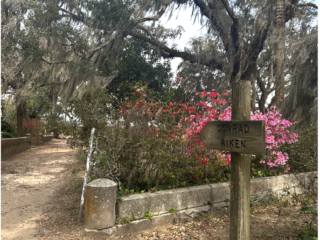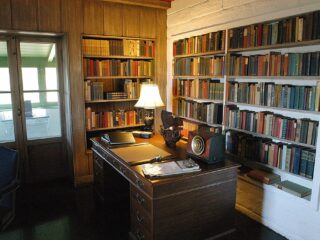By Lucy Gordon
pen to guests and visitors, Casa Guidi in Florence, where Robert and Elizabeth Browning spent their idyllic married life, offers us a firsthand glimpse of their lasting passion for Italy, poetry, and each other.
On the afternoon of September 12, 1846, fragile poetess Elizabeth Barrett defied her tyrannical and fanatically religious father, Edward, the widowed scion of rich Jamaican slaveholders. With faithful maid, Elizabeth Wilson, her only companion, she slipped out of the family home on London’s Wimpole Street and married Robert Browning in secret at St. Marylebone Parish Church. She was 40; Robert was six years younger. She was already acclaimed for her verses; he was yet to achieve widespread fame.
The couple was passionately in love. They had met in May 1845, though Robert was already an admirer of Elizabeth’s poetry and had been writing love letters to her for several months before their first meeting.
After the wedding, the couple separated and did not meet again for a week, when they “eloped” to Italy. With them they took Wilson, Elizabeth’s golden cocker spaniel named Flush (later immortalized by Virginia Woolf in her book of the same name), her love letters from Robert, and a few books. After six months in Pisa, they settled in Florence in April 1847.
They made their home at the Palazzo Guidi, affectionately nicknamed “Casa Guidi” by Elizabeth. “When all’s said and signed,” she wrote to Miss E.F. Haworth, an old friend of Robert’s, “I love Ital–I love my Florence…Florence is my chimney-corner, where I can sulk and be happy.”
A few hundred yards from Palazzo Pitti (the Grand-ducal palace, now art museum) and less than a five-minute walk from Ponte Vecchio, this aristocratic building, begun in the 15th century, is situated at Piazza San Felice 8, a small irregular square in Oltarno, or “across the River Arno.” It was a quiet residential neighborhood in the poets’ time and remains so today.
Here, on March 9, 1849, the couple’s only child was born, a son christened Robert but always referred to as “Pen.” And it was also here, in June 1861, after a happy 14 years in Florence, that Elizabeth died in Robert’s arms. A month after her burial in the Protestant cemetery at Porta Pinti, an inconsolable Robert left the city with their son, never to return.
Inside Casa Guidi
Elizabeth and Robert’s Florentine home consisted of six furnished rooms, plus a kitchen, entrance hall and two long terraces on the piano nobile, or main floor of the building. The furniture, which was fit for their predecessor, a Russian prince, was very grand. They quickly replaced the satin couches and marble consoles with their own belongings, and negotiated a decrease in rent plus free admission to the nearby Boboli Gardens.
In her first letter from Casa Guidi, dated May 10, 1848, Elizabeth joyfully describes each room to her youngest sister and closest confidante, Arabel, boasting that the couple paid only 25 guineas for “seven rooms, three of which are magnificent and the others excellent…to say nothing of our terraces.” About her bedroom, she confides: “We have discovered under the carpet…that the floor is all in scagliola, the arms of the Count Guidi there in many colours…” and about the drawing room: “The walls are green, the chairs crimson, with white and gold frames, and the carpet mixes up all colours. The ceiling has a good deal of gilding in Italian fashion…”
Here Elizabeth, an adoring wife, doting mother and ardent admirer of the Italian statesmen, Camillo Benso di Cavour, whose sudden death broke her heart, wrote her letters and poetry, “Sonnets from the Portuguese” (1850),” Casa Guidi Windows” (1851),” Aurora Leigh” (1857), “Poems Before Congress” (1860), and received a steady stream of visitors including English art critic and writer John Ruskin, American sculptor and writer William Wetmore Story and his family, English novelist Anthony Trollope and his novelist mother, Frances. Kate Field, a young American friend and frequent visitor between 1859 and 1861, recorded her impression of the drawing room in her obituary of Elizabeth published in the September 1861 issue of the Atlantic Monthly:
There was something about this room that seemed to make it a proper and special haunt for poets. The dark shadows and subdued light gave it a dreamy look, which was enhanced by the tapestry-covered walls and the old pictures of saints that looked out sadly from their carved frames of black wood. Large book-cases, constructed of specimens of Florentine carving selected by Mr. Browning, were brimming over with wise-looking books. Tables were covered with more gayly bound volumes, the gifts of brother authors. Dante’s grave profile, a cast of Keats’ face and brow taken after death, a pen-and-ink sketch of Tennyson, the genial face of John Kenyon,…little paintings of the boy Browning, all attracted the eye in turn, and gave rise to a thousand musings. A quaint mirror, easy-chairs and sofas, and a hundred nothings that always add an indescribable charm, were all massed in this room. But the glory of all, and that which sanctified all, was seated in a low arm-chair near the door. A small table, strewn with writing-materials, books, and newspapers, was always by her side.
Before departing, Robert had wished to record his happy years at Casa Guidi with a photograph of this room. On finding the lighting unsuitable he commissioned his friend George Mignaty, a Greek artist with an English wife, to paint an oil sketch. The painting, currently on loan to Baylor University in Waco, Texas, belongs to Mills College in Oakland California.
A Literary Landmark
Casa Guidi remained in the Guidi family’s ownership until 1893, when it was purchased by Pen Browning. He intended to restore it as a memorial to his parents, but died intestate (without a will) on July 8, 1912, and his heirs sold the house to Ellen Laura Hutchinson, an American from Georgia. She and her Italian husband, Giuseppe Centaro, also wanted to preserve it as a memorial and in 1916 helped form an Italian-British-American “Browning Foundation.” The house remained in the Centaro family until 1969, when, hearing that the property was in danger of being broken up into commercial offices, the New York Browning Society raised enough money to buy the piano nobile and put it in the ownership of newly created Browning Institute.
In 1992, ownership was transferred to Eton College, which together with the Landmark Trust, opened Casa Guidi to the public in July 1995. Today the house is partly furnished as it was during the poets’ time and paying guests may write poetry at Robert’s desk, sleep in Elizabeth’s bedroom, or seek inspiration on the terrace whence Robert and Elizabeth watched the political demonstrations in support of the unification of Italy–the muse for Robert’s “Men and Women” and much of Elizabeth’s verse.
Poetry in Residence
For information about staying at Casa Guidi, contact the Landmark Trust, Shottensbrooke, Maidenhead, Berkshire SL6 3SW, tel. 011-44-1628-825925. The apartment may be occupied by up to six people at rates ranging from $220 to $225 per night, with a three-night minimum. Those who are not guests may visit from November through April, Monday, Wednesday, and Friday, 3-6 PM. But before going, be sure and read Julia Markus’s riveting Dared and Done: The Marriage of Elizabeth Barrett and Robert Browning, (Knopf, 1995) and the informative Brownings of Casa Guidi by Edward C. McAleer (Browning Institute, 1979).
About the photo above
This is the drawing room at Casa Guidi today, after reopening to guests. Elizabeth usually wrote here, sitting in a chair with her feet up. The Brownings acquired the mirror while furnishing their home in June 1848. That same month, in a letter to her sister Henrietta, EBB wrote: “We have been extravagant enough to give five pounds for a glass above the drawing room fire place–not very large, but with the most beautiful carved gilt frame I ever saw in my life. Two cupids hold lights at the lower part. It belonged to the French charg, d’affaires…from whom we have bought many other things.”
The mirror is unique in as much as it is directly referred to by Browning in his poetry, in “The Ring and the Book”:
The book was shut and done with and laid by
On the cream-coloured massive agate, broad
‘Neath the twin cherubs in the tarnished frame
O’ the mirror, tall thence to the ceiling top.
*
More Articles on Italy
Rousing Nietzche in Orta, Italy
Michelangelo, The Flower of Florence
Sun & Moon in Montepulciano, Under the Tuscan & New Film Locations
Purchase Ereaders
Buy Robert Browning Ebooks
Travel to Florence Italy
Get the best Digital Cameras and Travel Cameras
Take an Robert Browning Tour
Visit Historic Hotels in Florence Italy
Discuss Robert Browning on LiteraryTraveler.net








